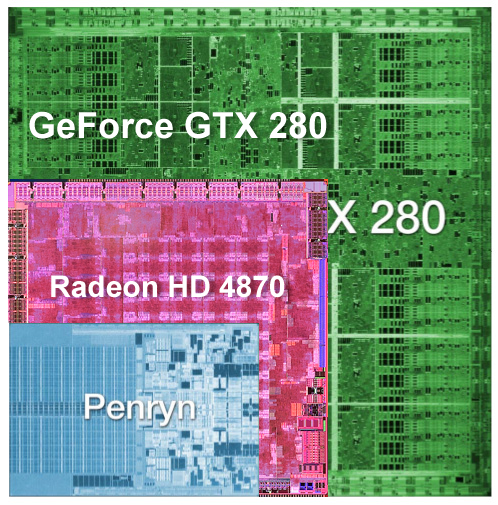The Radeon HD 4850 & 4870: AMD Wins at $199 and $299
by Anand Lal Shimpi & Derek Wilson on June 25, 2008 12:00 AM EST- Posted in
- GPUs
AMD's "Small-Die" Strategy
We outlined AMD's "new" GPU strategy in our Radeon HD 4850 preview article, but in short AMD has committed to designing GPUs for the mainstream $199 - $299 segment and simply using CrossFire (multi-GPU) to address higher end markets. NVIDIA on the other hand will continue to make very large monolithic GPUs in order to continue to push the industry forward. Both approaches are appreciated and necessary, they simply target different markets.
In our GT200 review we highlighted the fact that NVIDIA had built an extremely large, highly parallel, microprocessor. With 1.4 billion transistors and a die size of around 576 mm^2, NVIDIA's GT200 is nothing short of huge.
The table on the previous page shows that AMD's RV770, despite being aimed at mainstream gamer price points ($199 - $299), is also very large. At 956M transistors, the RV770 has 44% more transistors than RV670 and 68% the transistor count of NVIDIA's GT200. We threw the RV770 into NVIDIA's die size comparison just for kicks:

Based on what we know of NVIDIA's die size, this should be to scale
Even AMD's die, although designed to be svelte and affordable, is big - especially for being fabbed at TSMC. NVIDIA still holds the crown for largest die fabbed at TSMC, but AMD shows us that even a more mainstream approach still requires tons of transistors. As we mentioned in our 4850 preview:
"A pair of RV770s, AMD's new GPU, end up consuming more power than a single GT200 - despite being built on a smaller 55nm process.
A pair of these RV770s only costs $400 compared to $650 for a single GT200, but I suspect that part of that is due to differences in manufacturing process. If NVIDIA hadn't been so risk averse with the GT200 and built it on 55nm (not that I'm advocating it, simply posing a hypothetical), the cost differences would be smaller - if not in favor of NVIDIA since GT200 is built on a single card.
When the smoke clears, AMD's strategy is to simply build a GPU for the masses and attempt to scale it up and down. While NVIDIA is still building its GPUs the same way it has for decades, starting very large and scaling down.
AMD isn't taking a radically different approach to building and designing GPUs than NVIDIA, it's simply building one market segment lower."
We've got a lot of discussion on efficiency between AMD and NVIDIA coming up in this article, although AMD's die is noticeably smaller than NVIDIA's - as you've already seen with the Radeon HD 4850 - there are many areas where RV770 can go toe-to-toe with NVIDIA's mammoth GT200.










215 Comments
View All Comments
paydirt - Wednesday, June 25, 2008 - link
You guys are reading into things WAY too much. Readers understand that just because something is a top performer (right now), doesn't mean that is the appropriate solution for them. Do you honestly think readers are retards and are going to plunk down $1300 for an SLI setup?! Let's leave the uber-rich out of this, get real.So a reader reads the reviews, goes to a shopping site and puts two of these cards in his basket, realizes "woah, hey this is $1300, no way. OK what are my other choices?"
This review doesn't tell people what to do. It's factual. You (the AMD fanbois) are the ones being biased.
Jovec - Wednesday, June 25, 2008 - link
"This fact clearly sets the 4870 in a performance class beyond its price."Or maybe the Nvidia card is priced above its performance class?
DerekWilson - Wednesday, June 25, 2008 - link
it could be both :-)Clauzii - Wednesday, June 25, 2008 - link
I think You are right. nVidia had a little too long by themselves, setting prices as seen fit. Now that AMD/ATI are harvesting the fruits of the merger, overcomming the TLB-bug, financial matters (?), etc. etc. it seems the HD48xx series is right where they needed it.This is bound to be a success for them, with so much (tamable) raw power for the price asked.
Clauzii - Wednesday, June 25, 2008 - link
Yeah! Nice to see competition get into the game again.gigahertz20 - Wednesday, June 25, 2008 - link
Page 21 is labeled "Power Consumption, Heat and Noise" in the drop down page box, but it only lists power consumption figures. What about the heat and noise? Is it loud, quiet? What did the temperatures measure at idle and load?abzillah1 - Wednesday, June 25, 2008 - link
I am in love0g1 - Wednesday, June 25, 2008 - link
"NVIDIA's architecture prefers tons of simple threads (one thread per SP) while AMD's architecture wants instruction heavy threads (since it can work on five instructions from a single thread at once). "Yeah, they both have 10 threads but nV's threads have 24 SP's, AMD's 80 SP's. But the performance will probably be similar because both thread arbiters run about the same speed and nv's SP's run about double the speed, effectively making 48SP's (and in some special cases 96).
ChronoReverse - Wednesday, June 25, 2008 - link
Perhaps it's drivers but if AMD intends for the 4870x2 to compete as the "Fastest Card", they better fix their drivers ASAP.FITCamaro - Wednesday, June 25, 2008 - link
With a few driver revisions it will likely improve.